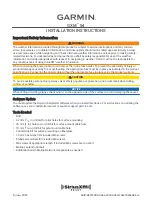
72
i.
Visually inspect all welds in aluminum tubes of reflector back structure for any evidence of cracking
.
If cracks are found, do not resume operation of the antenna. Contact the manufacturer immediately.
j.
The light bulbs , P/N 878-0221-12, included with the Obstruction Light Kit (174185) are rated for a
life span of 7500 hours. The kit includes two spares for replacement as necessary. See Section 6.1
paragraph 6A.8 for replacement instructions.
k.
Inspect the interface between the aluminum back structure and the steel antenna base. This faying
surface has been sealed with polysulfide in the factory and should be inspected for evidence of
corrosion or loss of sealant. Remove any corrosion with a wire brush and wipe clean. Re-paint the
area as required using the Touch-up Paint Kit (174499). Apply new sealant after paint has cured (48
hours).
1.
Inspect the feed radomes (windows) for cleanliness. Carefully wipe clean with damp cloth if
required. Do not use any solvents for cleaning. If necessary replace the radome (feed window) as
described in Section 6.2.
m.
The waveguide flange joints have been encapsulated with polysulfide sealant. Inspection of these
fasteners should only be required if it is suspected that a pressure leak has developed. If this occurs
remove the sealant on the suspect flange connection and inspect the bolt torque (should be 8 ft-lbs)
and re-apply sealant.
4.3
DISASSEMBLY PROCEDURES
4.3.1 Disassembly of the Dual Feed Assembly
Proper mechanical alignment of the dual feed assembly components can be performed only at the
factory. Flanges on both ends of the polarizer and dual feed support are pinned together to ensure
proper alignment is maintained. However, some components in the polarizer assemblies can be
replaced without disturbing the critical mechanical alignment of the dual feed assembly. This
includes replacement of the motor, the capacitors and the diodes. DO NOT DISTURB any
mechanical adjustment that affects either the range or the depth of dielectric vane movement within
the square waveguide section. Refer also to Section 1.6.4.7 for Polarizer/Feed Theory of Operation.
Polarization motor removal and replacement:
1)
Remove 16 screws that attach the cover to the polarizer.
Summary of Contents for 174100
Page 17: ...17 Figure 1 1 Typical Pattern Azimuth...
Page 18: ...18 Figure 1 2 Typical Pattern Elevation...
Page 19: ...19 Figure 1 3 Polarizer Schematic...
Page 20: ...02 08 2016 SDR ASR11 052 TI 6310 59 20...
Page 22: ...22 Figure 3 1 Complete Antenna Installation...
Page 23: ...23 Figure 3 2 Shipping and Support Stand...
Page 33: ...33 Figure 3 3 Base Interface Kit PSR Base Assembly...
Page 35: ...35 Figure 3 4 Fixed Feeds Unit Installation...
Page 42: ...42 Figure 3 5 Ladder Kit Installation...
Page 45: ...45 Figure 3 6 PSR SSR Interface Mount Installation...
Page 49: ...49 Figure 3 7 Antenna Lift Kit Installation...
Page 54: ...54 Figure 3 8 Waveguide Installation...
Page 55: ...55 Figure 3 9 Waveguide Hanger Installation...
Page 61: ...61 Figure 3 11 SSR Coaxial Cable Installation and Tilt Scale Bracket Installation...
Page 65: ...65 Figure 3 12 Antenna Feedhorn and Tilt Alignment Contour Cheek...
Page 66: ...66 Figure 3 13 Antenna Azimuth Alignment...
Page 67: ...67 Figure 3 14 Counterweight Installation...
Page 81: ...02 08 2016 SDR ASR11 052 TI 6310 59 75 This Page Intentionally Left Blank...
Page 82: ...76 Figure 4 1 Polarizer...
Page 83: ...77 Figure 4 2 Polarizer Motor Replacement...
Page 87: ...81 Figure 5 1 Test Antenna Kit...
















































